
Seattle-based Hsiao-Ching Chou has explored the intersection of food, storytelling and identity in a number of interconnected contexts: as a food columnist for the Seattle Post-Intelligencer, a cooking instructor, a PR entrepreneur, and a communications leader for top tech companies. Slow Food USA Communications Director Brian Solem chatted with Hsiao-Ching to learn more about her experiences bringing people in to make and appreciate Chinese food and ingredients, including Plant a Seed green yu choi sum.
What are some of your earliest food memories?
Growing up in my parents’ Chinese restaurant, I was always around food. But before we started our restaurant, my father was the assistant manager at a Dunkin Donuts shop. One of my earliest memories of cooking includes “helping” to frost donuts when I was four years old. In Taipei, my father worked for the military, but it’s often hard for immigrants to do what they did back home. So my parents had to find other means for making a living. I also have fond memories of making Jiffy mulberry cake with my mom in our tiny student-housing kitchen while my father was getting a masters degree in journalism.

What was it like to grow up in a Chinese restaurant in a small town in Missouri in the 1980s?
Our family’s Chinese restaurant was housed in an old Hardee’s fast food joint. We transformed the space into a Chinese kitchen, with second-hand equipment and makeshift improvements. The counter still had the takeout setup, and my mom even hand-lettered the menu board on poster board. It was a learning experience for my parents, because they hadn’t opened a restaurant before. We had to figure things out as we went along, constantly evolving and adapting. Several years later, we remodeled and expanded to a bigger location, which became a contemporary Chinese restaurant.
What inspired you to make food a central part of your career as a food writer, educator and cookbook author?
Food has always been intrinsic to our lives, especially because food is core to our Chinese culture. I also grew up in a family of storytellers and journalists — storytelling has been as much a part of my upbringing as food.
Being able to share the stories and experiences of others through food became a driving force for me. I have the ability to help people express themselves through words. Whatever intersection I’m at — tech and design, or food and editorial — my ability to recognize stories is the way that I want to expand opportunities for folx.
In 2018, you released your first book, Chinese Soul Food, followed by Vegetarian Chinese Soul Food in 2021. What inspired you to write these books? What was that experience like?
I was a full time food writer in my late 20s and early 30s for the Seattle Post-Intelligencer. At the time, I didn’t have the discipline to write a book; I tried, I started, but it kinda fizzled out. I didn’t have enough life experience yet to consider what the story is that I need to tell in book form. Columns don’t equal a cookbook! I lived my life, my career went on a different path, then I got married and had kids, and got into a different industry altogether. For a while, I took a break from food media. Being able to exercise different brain muscles and taking that space away from the day to day of food media was a gift.
After I caught my stride in a communications director role, there was a moment where I realized that I’d been working on this idea in the back of my mind, and it became crystal clear: It’s time to write this book! I wanted it to be everyday Chinese home cooking, with some family recipes as well as familiar recipes that, if you asked any Chinese or Taiwanese person and pointed at one of these dishes, they’d recognize it. They’re very familiar recipes. I also rolled in some family stories about the restaurant, about our family history.
When did you first try Yu Choy Sum?
I don’t remember the first time. Yu choy sum wasn’t always available in the U.S.; at least, it wasn’t available where I lived. I love the flavor of it, and it’s more tender than gai lan. It cooks really easily; I keep bunches in the fridge all the time so I can do a stir fry at a moment’s notice. Since I have access to Asian markets in Seattle, I will sometimes be able to find baby sized yu choy. The bigger ones are sometimes slightly overgrown and tougher. If you have access to a well-stocked Asian market, look for the baby ones.
Yu choy is versatile, great on its own, and great with other ingredients, especially garlic and soy sauce.

What’s next for you along your culinary and creative journey?
I’m co-writing my third cookbook with my daughter, who is 16. It’s called Feasts of Good Fortune and will be released next year. It’s about how we celebrate holidays as a Chinese-American family. My kids and their cousins are all mixed-race. I invited my daughter to be my co-author because I wanted this generation to have representation. I’ve observed how my daughter and her peers have many identity questions. They also talk about social justice, diversity, equity and inclusion — and they also connect over food. They compare dumplings a lot! My daughter will be contributing some essays throughout the book, where she’ll be interviewing people her age and other mixed-Chinese kids to understand from their perspective how they relate to our culture.
Stay in touch with Hsiao-Ching on Instagram at @HsiaoChingChou
This interview has been edited for length and clarity.

